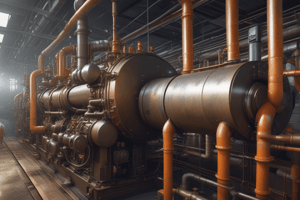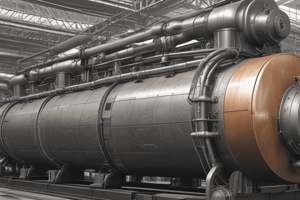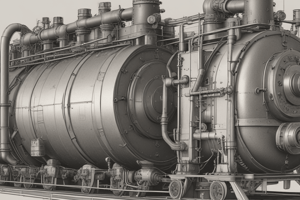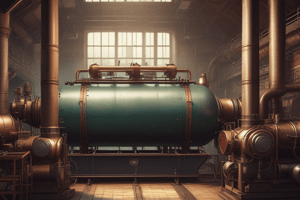Podcast
Questions and Answers
What is the major cause of forced outages in boiler systems?
What is the major cause of forced outages in boiler systems?
Boiler tube failures
What is the estimated overall availability loss due to boiler tube failures?
What is the estimated overall availability loss due to boiler tube failures?
- 6% (correct)
- 8%
- 4%
- 2%
Which of the following components are most commonly associated with boiler tube failures after many years of service?
Which of the following components are most commonly associated with boiler tube failures after many years of service?
- Reheaters (correct)
- Superheaters (correct)
- Water walls
- Economizers
Finned economizer tubes are relatively easy to access for thickness measurement and shielding.
Finned economizer tubes are relatively easy to access for thickness measurement and shielding.
What are the four main failure mechanisms of boiler pressure components?
What are the four main failure mechanisms of boiler pressure components?
Creep is a time-independent deformation that occurs at low temperatures.
Creep is a time-independent deformation that occurs at low temperatures.
What is the main cause of short-term overheat failure?
What is the main cause of short-term overheat failure?
Long-term overheat failure is primarily associated with a lack of cooling water.
Long-term overheat failure is primarily associated with a lack of cooling water.
What is the phenomenon of damage accumulation caused by cyclic or fluctuating stresses?
What is the phenomenon of damage accumulation caused by cyclic or fluctuating stresses?
What are the two categories of thermal fatigue?
What are the two categories of thermal fatigue?
What is metal removal caused by particles striking the metal's surface?
What is metal removal caused by particles striking the metal's surface?
Fly ash erosion is not a significant concern for boiler tube failures.
Fly ash erosion is not a significant concern for boiler tube failures.
What is defined as the deterioration and loss of material due to chemical attack?
What is defined as the deterioration and loss of material due to chemical attack?
What are the two basic categories of corrosion in boiler tubes?
What are the two basic categories of corrosion in boiler tubes?
What is the most common type of corrosion associated with excessive deposition on the inside surfaces of boiler tubes?
What is the most common type of corrosion associated with excessive deposition on the inside surfaces of boiler tubes?
Waterwall fireside corrosion occurs primarily on the inside surfaces of waterwall tubes.
Waterwall fireside corrosion occurs primarily on the inside surfaces of waterwall tubes.
What is the term used to describe the butt weld where an austenitic (stainless steel) material joins a ferritic alloy?
What is the term used to describe the butt weld where an austenitic (stainless steel) material joins a ferritic alloy?
DMW failures are always localized and do not typically result in catastrophic tube failures.
DMW failures are always localized and do not typically result in catastrophic tube failures.
What is the primary cause of waterside corrosion fatigue?
What is the primary cause of waterside corrosion fatigue?
Waterside corrosion fatigue is only a concern during boiler startup cycles.
Waterside corrosion fatigue is only a concern during boiler startup cycles.
Which of the following factors has the strongest influence on boiler tube failures, according to the provided information?
Which of the following factors has the strongest influence on boiler tube failures, according to the provided information?
The design of a boiler system does not play a role in mitigating boiler tube failures.
The design of a boiler system does not play a role in mitigating boiler tube failures.
Austenitic stainless steels are typically preferred for high-temperature boiler tube applications.
Austenitic stainless steels are typically preferred for high-temperature boiler tube applications.
During the design stage, what is a critical consideration for minimizing tube failures?
During the design stage, what is a critical consideration for minimizing tube failures?
Engineering and erection should prioritize speed over thoroughness, as delays can be costly.
Engineering and erection should prioritize speed over thoroughness, as delays can be costly.
During the commissioning stage, what is the importance of the hydro test of complete pressure parts?
During the commissioning stage, what is the importance of the hydro test of complete pressure parts?
What is the primary purpose of CAVT (Cold Air Velocity Test)?
What is the primary purpose of CAVT (Cold Air Velocity Test)?
What is the simplest NDT technique for identifying flaws and cracks in boiler tubes?
What is the simplest NDT technique for identifying flaws and cracks in boiler tubes?
Oxide scale measurement is an accurate technique for determining the remaining life of a boiler tube.
Oxide scale measurement is an accurate technique for determining the remaining life of a boiler tube.
RFET and LFET are both ultrasonic techniques for detecting flaws in boiler tubes.
RFET and LFET are both ultrasonic techniques for detecting flaws in boiler tubes.
What is the technique used for inspecting inaccessible internal surfaces of headers?
What is the technique used for inspecting inaccessible internal surfaces of headers?
What monitoring technique aims to identify potential blockages in the boiler circuit?
What monitoring technique aims to identify potential blockages in the boiler circuit?
During an overhaul, it is recommended to replace all DMW joints to prevent future failures.
During an overhaul, it is recommended to replace all DMW joints to prevent future failures.
It is considered best practice to inspect the economizer coils after lowering them down.
It is considered best practice to inspect the economizer coils after lowering them down.
Fly ash erosion is a primary concern in the wall blower area of the furnace.
Fly ash erosion is a primary concern in the wall blower area of the furnace.
What is considered a best practice for mitigating boiler tube leaks?
What is considered a best practice for mitigating boiler tube leaks?
The Performance Optimization Group is responsible for addressing all aspects of boiler maintenance, including chemical treatments.
The Performance Optimization Group is responsible for addressing all aspects of boiler maintenance, including chemical treatments.
Changing the coal burner is not recommended as it can lead to instability during operation.
Changing the coal burner is not recommended as it can lead to instability during operation.
The bottom ash hopper level should be maintained at the maximum level for efficient ash removal.
The bottom ash hopper level should be maintained at the maximum level for efficient ash removal.
Flashcards
What is the main issue affecting fossil power plant availability?
What is the main issue affecting fossil power plant availability?
Boiler tube failures are the leading cause of forced outages in fossil power plants, resulting in significant financial losses and reduced efficiency.
What are the key contributors to boiler tube failures?
What are the key contributors to boiler tube failures?
Boiler tube failures can be attributed to a combination of factors like poor design, incorrect fabrication practices, fuel changes, operational issues, and inadequate maintenance.
What are the financial implications of a boiler tube failure?
What are the financial implications of a boiler tube failure?
The cost of a boiler tube failure encompasses repair expenses, restart costs, and lost production revenue, significantly impacting the plant's profitability.
Explain the main failure mechanisms of boiler tubes.
Explain the main failure mechanisms of boiler tubes.
Signup and view all the flashcards
What is creep in boiler tubes?
What is creep in boiler tubes?
Signup and view all the flashcards
How does overheating affect boiler tubes?
How does overheating affect boiler tubes?
Signup and view all the flashcards
What is fatigue in boiler tubes?
What is fatigue in boiler tubes?
Signup and view all the flashcards
Explain erosion in boiler tubes.
Explain erosion in boiler tubes.
Signup and view all the flashcards
What is corrosion in boiler tubes?
What is corrosion in boiler tubes?
Signup and view all the flashcards
What is hydrogen damage in boiler tubes?
What is hydrogen damage in boiler tubes?
Signup and view all the flashcards
Explain waterwall fireside corrosion.
Explain waterwall fireside corrosion.
Signup and view all the flashcards
What is Dissimilar Metal Weld (DMW) failure?
What is Dissimilar Metal Weld (DMW) failure?
Signup and view all the flashcards
Explain waterside corrosion fatigue.
Explain waterside corrosion fatigue.
Signup and view all the flashcards
How does material selection impact boiler tube design?
How does material selection impact boiler tube design?
Signup and view all the flashcards
What are the potential risks of defects in tube manufacturing?
What are the potential risks of defects in tube manufacturing?
Signup and view all the flashcards
What design considerations can prevent boiler tube failures?
What design considerations can prevent boiler tube failures?
Signup and view all the flashcards
How do engineering and erection stages contribute to boiler tube reliability?
How do engineering and erection stages contribute to boiler tube reliability?
Signup and view all the flashcards
What are the key steps during commissioning and operation to prevent boiler tube failures?
What are the key steps during commissioning and operation to prevent boiler tube failures?
Signup and view all the flashcards
What are RFET and LFET and how are they used in boiler tube inspection?
What are RFET and LFET and how are they used in boiler tube inspection?
Signup and view all the flashcards
Explain the Time of Flight Diffraction (TOFD) technique used in boiler tube inspection.
Explain the Time of Flight Diffraction (TOFD) technique used in boiler tube inspection.
Signup and view all the flashcards
What are CAVT and CFD modeling and how do they contribute to boiler management?
What are CAVT and CFD modeling and how do they contribute to boiler management?
Signup and view all the flashcards
What are robotic inspection using magnetic flux and boroscopic inspection?
What are robotic inspection using magnetic flux and boroscopic inspection?
Signup and view all the flashcards
What are some key monitoring techniques used to prevent boiler tube failures?
What are some key monitoring techniques used to prevent boiler tube failures?
Signup and view all the flashcards
What is lifetime monitoring and how is it used?
What is lifetime monitoring and how is it used?
Signup and view all the flashcards
What are some critical practices during boiler overhauls?
What are some critical practices during boiler overhauls?
Signup and view all the flashcards
What are some key strategies for controlling boiler tube leaks?
What are some key strategies for controlling boiler tube leaks?
Signup and view all the flashcards
What is the role of a performance optimization group?
What is the role of a performance optimization group?
Signup and view all the flashcards
Study Notes
Boiler Tube Failures
- Boiler tube failures are a significant cause of forced outages in fossil fuel power plants
- These failures contribute to a 6% overall availability loss across units
- Failures are often linked to poor initial design, fabrication practices, fuel changes, operation, maintenance, and cycle chemistry
Presentation Layout
- Introduction to boiler tube failures
- Statistics on tube failures
- Cost analysis of tube failures
- Types of tube failures and associated failure mechanisms
- Factors influencing tube failures
- Methods for detecting tube failures
- Guidelines to prevent and control tube leaks
- Best practices for preventing tube leaks
Boiler Pressure Component Failure
- Boiler pressure components are complex, critical, and vulnerable in fossil fuel power plants
- Failures in these components historically lead to the highest percentage of lost availability
- These failures are often associated with poor initial design, fabrication practices, fuel changes, operation, maintenance, and cycle chemistry
Statistics of Tube Failures
- Statistical data on boiler tube failures is from the CEA
- A significant portion of data is related to water wall, superheater, economizer, and reheater failures across various capacity units (MW) across various types of boilers
- Data shows the frequency and impact of outages on different types of units
Boiler Tube Failures Post Overhaul
- Percentage of failures within a week after overhaul. Data collected between April 2007 and December 2011 shows varied failure rates (percentage) across different power plants
Boiler Tube Failure Zones
- Regions of the boiler known for higher failure rates. The percentages of failures differ with differing locations in the boiler system
Cost of Boiler Tube Failures
- Costs consist of repair expenses, startup oil costs, and lost production costs.
- Approximate repair costs are $200,000 per day
- Hourly downtime costs are associated with the lost generation
- Startup oil costs are roughly $7,500,000 per 150KL startup
Prominent Reasons for Tube Failures
- Poor water quality: With increasing operating pressure, feedwater quality is crucial.
- Changing coal quality: Adversly impacts boiler operability, and reliability.
- Cycling operation: Design issues and rapid changes affect the boiler's reliability and are likely sources for corrosion and damage
- NOx emissions: Deep staging combustion for NOx reduction has been implicated in serious waterwall fire corrosion in high-sulfur coal-fired supercritical units.
- Ageing: Many fossil fuel units are exceeding their design life, leading to increased stress and failure risks.
Economizer Effects
- Finned economizer tubes are difficult to inspect and measure due to poor access for thickness measurement and shielding.
- Economizer tube bends close to casing walls are also difficult to access
Typical Failure Mechanisms
- Boiler tubes operate in high pressure and temperature environments
- Failures can be caused by mechanical/thermal processes including creep, fatigue, erosion, and corrosion
Creep Failures - Overheating
- Short-term: Results in a ductile rupture where the fracture surface looks like a thin edge. These occur more commonly during startup.
- Long-term: Tube metal accumulates significant stress affecting the boiler tubes over long usage cycles
Fatigue
- Damage caused by repeated stresses
- Corrosion fatigue and thermal fatigue are common types of fatigue in tubes
- Tubes experience varying temperatures and flow causing damage from internal cracking and external surface cracking, amongst other effects
Erosion and Corrosion
- Erosion: Particle strikes and metal removal
- Corrosion: Material deterioration due to chemical attack. Types of corrosion include internal corrosion to external corrosion in the different areas of the boiler
Internal Corrosion-Hydrogen Damage
- Excessive hydrogen deposition along tube surfaces contributes to failures
- pH fluctuations, condenser leaks, and acidic deposits contribute to hydrogen damage and deterioration
Waterwall Fireside Corrosion
- Corrosion occurs on external waterwall tube surfaces.
- Reducing atmospheres during combustion are a leading cause, particularly in pulp and paper industry boilers.
- Improper burner operation can exacerbate corrosion.
Dissimilar Metal Weld (DMW) Failure
- Occurs often at the weld fusion line and may fail catastrophically
- Caused by high stresses at the interface and differing expansion properties between the various types of materials
Waterside Corrosion Fatigue
- Tube damage from thermal fatigue and corrosion
- Boiler design, water chemistry, oxygen content, and boiler operation affect the extent, occurrence, and severity of corrosion fatigue.
- Breakdown of protective magnetite scale that exposes the tubes to corrosion
- Locations with attachments (e.g., buckstays, seal plates, scallops) are more prone to this specific effect
Factors Influencing Boiler Tube Failures
- Data summaries the respective influence of various causes including design, operation, and maintenance issues
Water-Touched Tubes
- Detailed table showing influences of design, operation, and maintenance causes
Critical Considerations during Boiler Design
- Material selection is critical based on expected operating temperatures.
- Economizers and waterwall sections usually employ mild or medium carbon steel.
- Superheater and reheater sections often utilize low alloy ferritic steel, while highly stressed zones employ austenitic stainless steel.
- ASME codes are based in part on mid-wall tube temperatures
Metal Temperature Limits
- Data table including various tube steel types, ASME specifications, and maximum allowable temperatures for various manufacturers
Material and Fabrication Flaws
- Defects introduced during manufacturing, storage, or installation, These flaws include forging laps, inclusions, lack of fusion, deep tool marks, gouges, and dents
- Flaws lead to failures, especially in high-temperature zones
Control of Boiler Tube Leak During Design
- Adequate furnace sizes, alignment of coils, uniform spacing, material selection, and maintenance locations must be considered during this stage
Engineering and Erection Stage Aspects
- Tube material procurement and technical specifications must be sound according to codes
- Design reviews and mechanical details should consider reliability
- Fabrication processes should use conservative procedures for new materials.
- Inspection and documentation of weld locations and areas with changed tube material should be detailed
- Alignment, spacing, support, and quality of weld joints is critical.
Manufacturing and Erection Stage Aspects
- Quality checks throughout manufacturing, alignment of coils/panels, spacing across coils and walls, erection quality, and quality of site weld joints
Commissioning and Operation Stage
- Removal of temporary supports/structures
- Hydro test of pressure parts (and other checks)
- Quality of various chemical cleaning processes, and steam blowing
- Repeat CAVTs (Cold Air Velocity Testing) after correction of issues
- Optimizing soot blowing operations, and other various checks
Techniques to Detect Boiler Tube Leaks
- Extensive Dye Penetrant Testing for identifying flaws
- Oxide scale measurement to help determine the lifetime remaining on tubes by measuring the temp effects
- Modern techniques for flaw detection
NDT Techniques
- Describing Remote Field Electromagnetic Technique (RFET) as a suitable means for identifying internal flaws
- Low Frequency Electromagnetic Technique (LFET) allows scanning of tube surfaces for inspecting flaws
Time of Flight Diffraction (TOFD) Technique
- Describing how ultrasonic inspection can identify cracks in thicker components
- Checking for cracks and lack of fusion
CFD Modeling and CAVT Testing
- Using CFD modeling to predict flow profiles to detect potential issues
- Performing CAVT (Cold Air Velocity Test) to assess air flow, and using thermography to assess for issues
- Identifying potential blockage issues in water-wall tube walls
Robotic Inspection Using Magnetic Flux
- Using robotic inspections for detecting thickness loss in water wall tubing
- Boroscopic inspections are used for identifying crack issues
Monitoring Techniques
- Water temperature excursion monitoring
- Chemical parameter monitoring for pH, Na, DO, NH3 & PO4
- Dissolved oxygen level monitoring
- Detecting boiler tube leaks through Acoustic Steam Leak Detection
Operation and Maintenance Guidelines to Address Boiler Tube Leaks
- Procedures (and considerations) to be taken for controlling boiler tube leaks (including DMW, excessive fly-ash deposition)
- Specific actions to be taken during various stages of operations and maintenance
Approach Methodology to Prevent Boiler Tube Leaks
- Flowchart for approach method including pre-checks for possible BTL or other potential issues, and the various tracks
- Steps from before and during outage to after and during post-outage checks
Measures to Control Boiler Tube Leaks
- Procedures that should/must be maintained to reduce the risk
- Considerations for utilizing the steps effectively
Studying That Suits You
Use AI to generate personalized quizzes and flashcards to suit your learning preferences.





